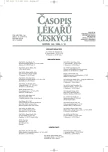Purkyně´s Concept of Neuron
Authors:
J. Pokorný; S. Trojan
Authors‘ workplace:
Fyziologický ústav 1. LF UK, Praha
Published in:
Čas. Lék. čes. 2005; 144: 659-661
Category:
Review Article
Overview
#With his experiments and findings J. Ev. Purkyně influenced 34 scientific disciplines; in some of them he is assumed to be their founder (embryophysiology, histology, pharmacological physiology, biophysics, comparative physiology). He was the pioneer in the field of neuroscience not only due to his neuroanatomical descriptions but namely due to his neurophysiological experiments. Beside the description of “Purkyně cells” and cells of other regions of the brain, Purkyně studied also the structure of neuronal processes and it is possible to attribute him the first description of dendrites. Existing material shows that Purkyně studied also the structure of hippocampus. Those and other papers prove that Purkyně recognised possible functional differences between various types of neurons and he speculated about their mutual relations. Only contemporary particularly detailed knowledge on the structure of hippocampal neuronal circuits, description of the mediator interaction and modulation together with the identification of neuroplastic processes in the hippocampus enable to accomplish the Purkyně´s attempt to correlate the structure and function.
Key words:
J. Ev. Purkyně, nerve fibre, hippocampus, principal neuron, interneuron.
Labels
Addictology Allergology and clinical immunology Angiology Audiology Clinical biochemistry Dermatology & STDs Paediatric gastroenterology Paediatric surgery Paediatric cardiology Paediatric neurology Paediatric ENT Paediatric psychiatry Paediatric rheumatology Diabetology Pharmacy Vascular surgery Pain management Dental HygienistArticle was published in
Journal of Czech Physicians

Most read in this issue
- Heart Rate Variability During Sleep
- Alternating Hemiplegia of Childhood (AHC)
- Intermittent Catheterization of Urinary Bladder – Indications, Technique, Complications
- Alcohol and Pregnancy
